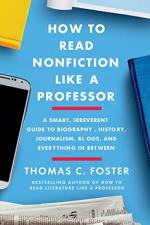
|
| Name: _________________________ | Period: ___________________ |
This test consists of 15 multiple choice questions and 5 short answer questions.
Multiple Choice Questions
1. In Chapter 2, "The Ecology of the Nonfiction Biosphere," Foster notes that the expectation for a writer to be engaging does not apply to which types of writing?
(a) Political.
(b) Technical.
(c) Academic.
(d) Informational.
2. In Chapter 6, "Source Code," what type of writing does Foster say relies heavily on eyewitness testimony?
(a) Op-eds.
(b) Journalism.
(c) Science.
(d) History.
3. In Chapter 2, "The Ecology of the Nonfiction Biosphere," Foster calls an expression a "bromide." What is he saying about this expression?
(a) It is insightful but wordy.
(b) It is boring and mean-spirited.
(c) It is clever and concise.
(d) It is unoriginal and unimportant.
4. In Chapter 5, "It May Just Be Me, But..." what does Foster say about disclaimers like "I don't dislike soccer" (52)?
(a) That it probably means the speaker actually does dislike soccer.
(b) That double negatives are generally used to disguise a lie.
(c) That it is good when authors clarify what ground is "neutral" to them.
(d) That this kind of phrasing often introduces counterclaims.
5. In Chapter 5, "It May Just Be Me, But..." Foster says that a source's quote can be "emended" (55). What happens to an emended quote?
(a) It is verified.
(b) It is updated.
(c) It is shortened.
(d) It is withdrawn.
6. In Chapter 8, "Bringing the News," Foster maintains that types of newspaper writing like advice columns and human interest stories exist for what reason?
(a) To fill up space not needed for daily news.
(b) Because they are traditional.
(c) To sell newspaper advertising.
(d) Because readers can not live without them.
7. In Chapter 5, "It May Just Be Me, But..." what does Foster say about offering equal space and analysis to opposing arguments?
(a) It strikes the modern reader as dishonest.
(b) This is part of fair and balanced reporting.
(c) This can destroy a story.
(d) It is confusing to the reader.
8. In Chapter 7, "All in How You Look at Things," what does Foster say beginning writers often get too caught up in?
(a) Narrative.
(b) Dialogue.
(c) Exposition.
(d) Description.
9. In Chapter 6, "Source Code," what does Foster call the "gold standard" of sources (63)?
(a) Expert sources.
(b) Eyewitness testimony.
(c) Professional expertise.
(d) Statistics.
10. In Chapter 3, "The Power of the Prologue," Foster uses the word "etymologically" to describe what?
(a) The opposites of words.
(b) The definitions of words.
(c) Similar sounding words.
(d) The origins of words.
11. In Chapter 8, "Bringing the News," one of the main points that Foster wants to make about All the President's Men is what?
(a) It is unusual for people to write about themselves in the third person.
(b) Woodward and Bernstein used too many anonymous sources.
(c) All the President's Men is a work of nonfiction.
(d) Woodward and Bernstein faced serious obstacles in investigating the Watergate story.
12. In Chapter 5, "It May Just Be Me, But..." what does Foster say is usually the difference between quoted anonymous sources and sources speaking "on background"?
(a) The only difference is actually whether the information is quoted or paraphrased.
(b) Background sources tend to be highly-placed officials, while anonymous sources tend to be leakers.
(c) Quoted anonymous sources are more likely to be accurate than information obtained "on background."
(d) Reporters are not usually asked to verify information obtained in a quote, but they are supposed to double-check information given "on background."
13. In Chapter 7, "All in How You Look at Things," Foster discusses Pollan's How to Change Your Mind as an example of what?
(a) Why self-help books are better off using a chronological structure.
(b) Why self-help books can use many non-chronological structures.
(c) Science writing that does not use chronological order.
(d) Science writing that begins in media res.
14. In Chapter 6, "Source Code," which is the only type of nonfiction that Foster says doesn't need "rock-solid" sources (69)?
(a) Biography.
(b) Reportage.
(c) Philosophy.
(d) Memoir.
15. The section of this book called "The Books in the Book" is what part of the book?
(a) The introduction.
(b) An appendix.
(c) A foreward.
(d) A preface.
Short Answer Questions
1. In Chapter 5, "It May Just Be Me, But..." what kind of person does Foster say is likely to be biased?
2. In Chapter 3, "The Power of the Prologue," Foster mentions a "squib." What is a squib, in this context?
3. In Chapter 4, "The Parts You Don't Read," what is a piece of information that Foster says we can infer from the notes?
4. In Chapter 2, "The Ecology of the Nonfiction Biosphere," what does Foster say is the difference between "hard news" and "soft news"?
5. In Chapter 8, "Bringing the News," one of the main points that Foster wants to make about All the President's Men is that it is a kind of writing he calls what?
|
This section contains 824 words (approx. 3 pages at 300 words per page) |

|




